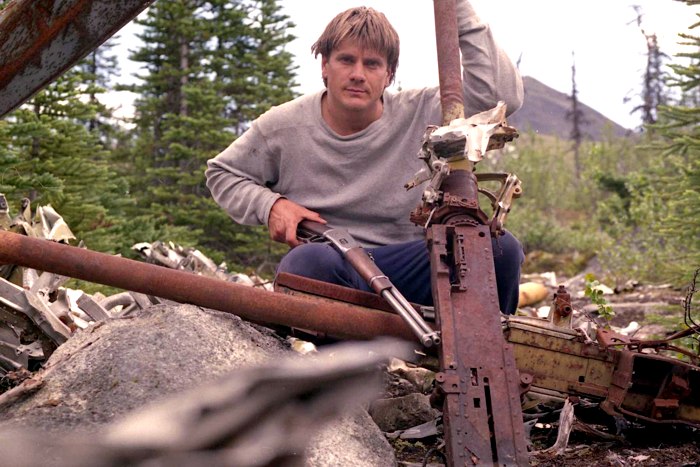Selected portions of this story appear in a book by Blake W. Smith, entitled Warplanes to Alaska — the story of a World War Two military supply lifeline to Alaska and Russia through the Canadian wilderness, featuring over 450 photographs, now available through Hancock House Publishers, 19313 Zero Avenue, Surrey, B. C., Canada, V4P 1M7 or telephone (604) 538-1114 or browse at: www.hancockhouse.com
I swung my rental truck off the Alaska Highway onto a heavily rutted dirt service road, dodging small boulders and a score of other obstacles—mindful that every inch gained up this rugged hillside was one less inch to be gained on foot. Finally the road had transformed itself into little more than a rocky trail and my wheels could carry me no further.
I double-checked to make sure I had all the usual safety and survival gear one would normally take on any hike alone, especially back into the rugged mountains of the Wolf Range in Canada’s Yukon Territory. I slung my pack over my shoulder and jabbed a half-dozen rounds into my vintage 30-30 Winchester lever-action rifle and set out on foot toward a gleaming 7,000 foot high mountain peak. This was a hunting trip of sorts but not for grizzly bear or mountain sheep so prevalent in the area but for a long-lost wreck of an American P-39 Airacobra fighter plane that had crashed upon one of these distant mountain ridges 55 years ago.
On this spectacular July morning the sun was just beginning to warm the uppermost peaks as I struggled my way up an old deteriorated track that paralleled a creek still swollen by spring run off. I paused briefly to examine my map, noting where I thought myself to be, then traced my finger to a penciled “X” indicating the approximate crash location—a distance I estimated to be about 9 miles. It was a bush pilot who had marked the spot on my map, having over flown the well-concealed wreck several years previously. I figured about seven solid hours of hiking to reach the general area, then who knows how long to actually find the wreck in the thick tangle of spruce bushes on the ridge. The northern summer days at this latitude offered nearly a full twenty-four hours of daylight so I had no concern of being caught by descending darkness.
I would be insincere if I didn’t admit to a little trepidation when I saw my first grizzly tracks imprinted in soft mud and it was at that point that I seriously questioned my judgment about continuing. Instead I gripped my Winchester a little tighter and pressed on trying to ignore the many morbid bear-attack stories I had heard over the years. Somehow I cast these fears aside and continued on but now faced having to cross the icy waters of a fast-flowing creek. Again I mustered the courage and worked my way over the slippery boulders, leaning into the strong current, my legs numb to the crotch. Three more times I had to cross these swirling waters before I rose out of the ravine and onto a plateau overlooking the ridge where the crashed Airacobra was said to lay hidden. The beautiful weather of morning had given way to the flash of lightning and crackle of thunder which rumbled down the valley and reverberated off the mountain peaks. A light rain began to fall from the thunder heads but the valley and mountains were partially illuminated by brilliant beams of sunshine. I marveled at the beauty of the panorama before my eyes, jagged mountain peaks still partially cloaked in snow, alpine bushes glowing green, yellow and crimson, then my mind drifted back to what I knew of that tragic October 27 day in 1943 . . .
Cold, stormy weather had swept in and stalled over the northern portions of the airway in mid-October 1943, as a result ferrying operations ground to a halt. In all, 257 aircraft were stalled at various bases over the entire route. These aircraft consisted of mostly P-39 Airacobra fighters, Douglas A-20 attack aircraft, B-25 medium bombers and C-47 transports—most destined for our Russian ally across the Bering Strait, provided under the lend-lease program. The Soviet Union was engaged in a life or death struggle with Nazi Germany and reeling from a succession of heavy blows which threatened her very existence. Against this backdrop the western Allies offered (and eventually contributed) from their combined arsenals material aid of all sorts including an estimated 20,000 aircraft, 14,833 from the United States of which 7,925 were delivered by way of a string of airfields extending from Great Falls, Montana to Fairbanks, Alaska, through northwestern Canada. American pilots of the 7th Ferrying Group, Air Transport Command, delivered these airplanes from Great Falls over this wilderness air route to waiting Russian pilots at Fairbanks. From there Soviet pilots continued the relay across the breadth of Siberia to the fighting front. Russia’s need for weapons, especially warplanes was desperate. A genuine sense of urgency was felt by everyone involved in the transfer of airplanes, from servicing personnel to pilots, as airplanes had to get to the fighting front as soon as humanly possible and that often meant “pushing” the weather.
Former 7th Ferrying Group pilot Carl H. Biron was one of these weather-bound pilots and recalls his longest trip to Alaska and the ill-fated flight of another pilot: “I departed Gore Field (Great Falls) on October 17, 1943 as part of a three-plane flight of Airacobras bound for Fairbanks. It was my eleventh trip to Fairbanks, all in P-39s. The first stop was Edmonton but due to poor weather conditions beyond this station we could not depart again until October 22. We worked our way up the line to Fort St. John and then onto Fort Nelson, where again we were weathered in. Several other flights of P-39s had also collected at Fort Nelson, about twelve to fifteen planes as I recall. We remained there until October 26, when we were cleared to Watson Lake but no further because of intense snow storms to the northwest of Watson Lake.”
“The following day, October 27, flight operations suggested we might be able to get around the storm system or possibly over the top. A number of us took off for a go at it, but within only a few minutes flight time we found ourselves in one hell of a snow storm. Doing a quick 180-degree turn, we returned to Watson Lake. The storm hit the airfield as we were touching down and it was difficult to see while even taxiing back to the ramp. I logged twenty minutes flight time that day. Another flight of two P-39s was not so lucky. They became separated and one of them attempted to land at Watson Lake. Unfortunately the field was ‘zero zero’ and he was on top. He had radio contact and we could hear him overhead but soon his engine sound faded away. We all prayed he would make Whitehorse.”
“It continued to snow the rest of the day and through the night. The following day there was still no report of the fate of one of the missing planes but the one we had heard overhead was successful in making it to Whitehorse. The snowplows cleared the runway and on October 29 we were able to fly search sorties in the area but without success. Because of their speed the P-39s made poor search planes, but it was all we had. We were not able to conduct search flights again until November 1 because of local weather conditions. By now so much snow had accumulated, it would probably have prevented us from seeing much of anything anyway. On November 2 the weather system moved out and we departed Watson Lake for Fairbanks. Total elapsed time over the route was sixteen days—a record longest trip for me.”
The lost pilot referred to by ferry pilot Carl H. Biron was twenty-three-year-old Lt.Walter T. Kent of Bagdad, Kentucky. His more fortunate wingman, and first timer to the Alaskan route, was Lt. William S. Day. Kent was a relatively experienced flight leader with more than 500 hours of flying time but without an instrument rating.
Their troubled flight began at 0900 hours when the two P-39s roared down the Watson Lake runway for their continued flight to Whitehorse. Snow squalls forced Kent to alter course continuously in order to stay in contact with the ground. Minutes later they were skimming low over the Alaska Highway and approaching the narrow mountain pass in the vicinity of Swift River. Here the jagged mountain peaks tower to well over 8,000 feet, on this morning snow flurries obliterated all but the bases. As they rounded a curve in the narrow valley they were confronted by a heavy snow squall blocking the pass. A l80-degree turn was impossible in the tight confines of the valley so without hesitation both pilots entered the swirling snow on instruments.
Losing sight of each other instantly Kent made a gradual climbing turn to the left, Day did likewise to the right. Lt. Day spiraled up through the murk, eventually breaking out on top at 12,000 feet and headed back to Watson Lake where he found the base socked in and was snowing heavily. An instrument approach was impossible because of radio static caused by snow storms. After thirty minutes of circling the field above the clouds, Day contacted Watson Lake Radio informing them of his intention to press on to Whitehorse in hope of better weather conditions there. A landing was made at that field without incident.
Lt. Kent was still unreported and presumed down. Search aircraft assembled from various bases. Poor weather hampered initial search efforts though several suspicious marks on mountain sides were discovered—these later proved to be of natural origin. After pilots scoured 22,500 square miles of wilderness over a several week period without success, Kent was officially declared “lost.”
Kent’s disappearance would be solved almost twenty-two years later. On September 18, 1965, an RCAF helicopter engaged in the search for a missing civilian airplane, spotted the glint of sun on metal and landed for a closer look. The wreckage lay well hidden in sub alpine bush north of Tootsee Lake, very near where Kent and Day first lost contact with the ground.
A recovered data plate confirmed the long-lost airplane to be that of Lt. Walter T. Kent’s P-39Q-15-BE Serial #44-2031. Nothing could be found in the way of skeletal remains, a fact that wasn’t surprising given the abundance of wolves in the area and the likelihood that remains would have been scattered by these animals. A few personal items were found: several coins, a high school ring with Kent’s name inscribed on the inside—all suggested Kent had been killed in the crash.
As to the cause of the crash, investigators speculated that Kent had lost control of the aircraft while flying in the zero visibility of cloud.
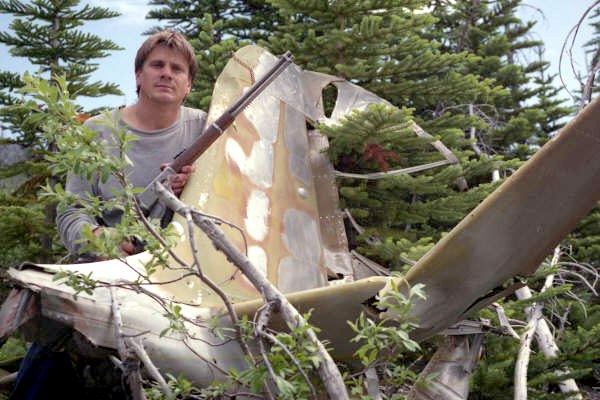
…I slopped on more mosquito repellant in a wishful but likely futile bid to thwart a voracious swarm of the pesky pursuers then started up the ridge in a “zigzag” pattern to where I expected to find the Airacobra. After a solid hour of difficult hiking I emerged above the tree line with the realization that finding this wreck may prove more challenging than first thought. As I was pondering the prospect of failure a light snow began to fall from a single large gray cloud overhead. The coincidence of Kent crashing during a snowstorm and the oddity of this July snow shower was not lost on me and I took it for a sign from above and pressed on with my search.
I zigzagged back down the ridge to where the spruce scrub became dense again and from the corner of my eye a silver-gray object caught my attention. With a jolt of excitement I realized that I had found a length of aluminum tubing—clearly aeronautical in origin! Ahead of me stood a thick screen of trees and sensing I was near the wreckage I plunged through the tangle of branches to emerge in a field of airplane wreckage. Yes! A severed wing…then another, over there the tail, remarkably intact and gleaming silver, once painted olive drab but more than a half-century of wind-driven snow had blasted most of the paint away. A machine gun here and another over there, the propeller…isn’t that odd I thought, one of the three blades is missing but the other two are virtually undamaged! A thousand pieces big and small were scattered about the clearing, all interesting and worth closer examination. I dropped the pack from my shoulders, glad to finally be free of the weight and placed my rifle within easy reach should I be caught unaware by a hungry grizzly. I was amazed at how complete the wreckage appeared to be even though it was demolished—evidently souvenir hunters had not discovered this one. Identifying pieces and trying to determine the attitude of the airplane and direction of flight at the moment of impact based on the pattern of strewn debris was an intriguing puzzle. The eleven hundred pound Allison engine was wrenched from its mounts and catapulted 200 yards down the hillside.
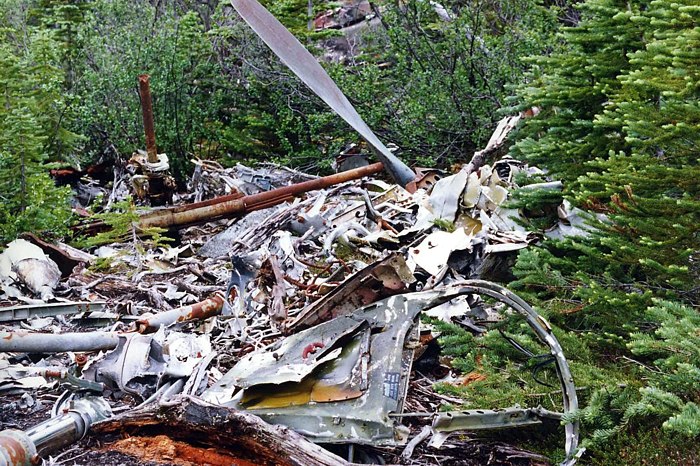
Judging from the mangled instrument panel and tangled rudder pedal assembly and connecting parts it appeared that the engine had passed through the cockpit on its way out—taking Kent with it (the Airacobra design featured the placement of the engine behind the pilot). Also scattered about were a number of items then carried by ferry pilots in a parachute “seat pack” survival kit. Contained in this kit were food rations, fishing line, snare wire, matches, a flare gun and a number of other useful items. From this survival kit I discovered among the debris several unopened ration cans and his brass flare gun. These, along with the discovery of the webbed seat belt harness, still clasped at the buckle but snapped at both anchor points confirmed that Kent had not escaped by parachute.
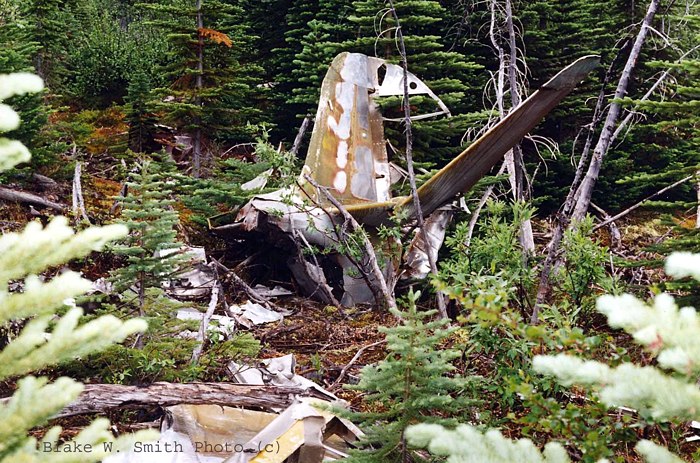
Two hours vanished in what seemed an instant and as I was preparing to depart a small metal object, rectangular in shape and gold in color, caught my eye. I picked it up and examined it; a strange feeling came over me as I realized that this was Kent’s brass lieutenant bar! It is odd how a scene of past tragedy, especially when one is acquainted with all the details thereof can cause one to feel a sense of presence. Perhaps it was the quiet and lonely wilderness that surrounds the site but I couldn’t help but imagining a young Lt. Kent dressed in flight suit sitting upon one of the broken wings watching me sift through the bits and pieces of his 55 year old resting place, wondering why I couldn’t see him. I said a respectful “good by” and started the long walk out.
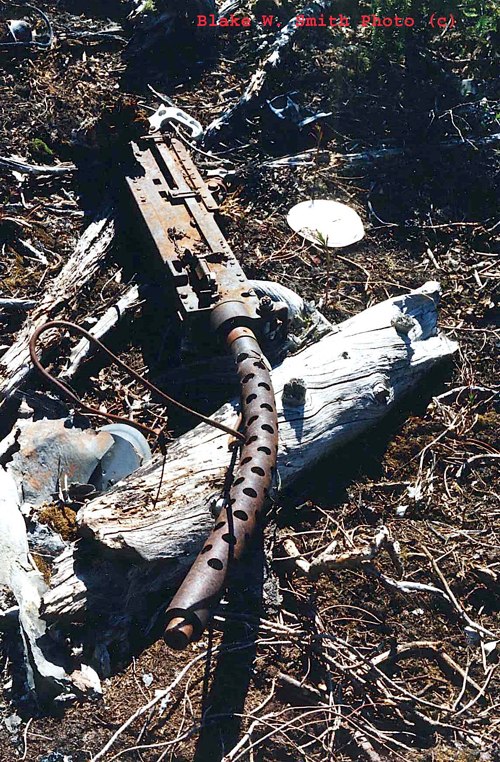
Authors note—the following summer I returned to the crash site with friend and fellow aviation enthusiast Dave Harris. The purpose of the return visit was to affix a small plaque which Dave had made as a tribute to Lt. Kent which read: “In memory of Walter T. Kent, 2nd Lt. USAAF, died here Oct. 27, 1943 in performance of his duties as a pilot attached to the 7th Ferrying Group. The cause of his untimely demise and his exact resting place are known only to God.
May he rest in peace.

